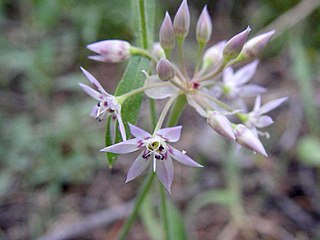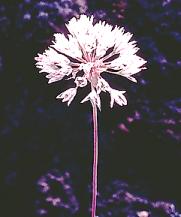
Chives, scientific name Allium schoenoprasum, is a species of flowering plant in the family Amaryllidaceae that produces edible leaves and flowers. Their close relatives include the common onions, garlic, shallot, leek, scallion, and Chinese onion.

Allium anceps, known as twinleaf onion and Kellogg's onion, is a species of wild onion native to the western United States. It is widespread in Nevada, extending into adjacent parts of California, Idaho, and Oregon. It grows in barren clay and rocky soils.

The Delhi Sands flower-loving fly is a subspecies of flower-loving fly, a member of the genus Rhaphiomidas in the Mydidae family. It was the first fly added to the Endangered Species List in the United States.

Allium cernuum, known as nodding onion or lady's leek, is a perennial plant in the genus Allium. It grows in open areas in North America.

Bidens amplectens, the Waiʻanae kokoʻolau, is a species of flowering plant in the family Asteraceae. It belongs to the genus Bidens, collectively called kokoʻolau or koʻokoʻolau in the Hawaiian language. It is found in coastal and dry lowland habitats in the Waiʻanae Range on Oʻahu. It is threatened by habitat loss due to the spread of invasive weeds and brush fires. The species is also threatened by climate change and habitat degradation, and herbivory. Bidens amplectens is currently listed as endangered under the Endangered Species Act.

Apodemia mormo langei, the Lange's metalmark butterfly, is an endangered North American butterfly. It is a subspecies of the Mormon metalmark and belongs to the family Riodinidae. The butterfly is endemic to California, where it is known from one strip of riverbank in the San Francisco Bay Area. A 2008 count estimated the total remaining population at 131 individuals. Since 2011, this number has dropped to about 25–30.

Allium serra is a California species of wild onion known by several common names, including jeweled onion, pom-pon onion, and serrated onion.

Allium campanulatum is a species of wild onion known by the common name dusky onion or Sierra onion. This is a flowering plant native to the western United States from southeastern Washington and northern Oregon to southern California, and western Nevada. The dusky onion grows in foothills and mountains, especially in dry areas, such as chaparral habitats.
Layia munzii is a rare species of flowering plant in the family Asteraceae known by the common name Munz's tidytips, or Munz's layia.
Allium bolanderi is a species of wild onion known by the common name Bolander's onion. It is native to northern California and southwestern Oregon, where it grows in the rocky soils of the Klamath Mountains and surrounding regions.

Allium burlewii is a species of wild onion known by the common name Burlew's onion. It is endemic to California, where grows in the granitic soils of several of the central and southern mountain ranges from Riverside and San Bernardino to Fresno and Monterey Counties, usually between 6,000 and 10,000 feet above sea level.

Allium howellii is a North American species of wild onion known by the common name Howell's onion. It is endemic to California.

Allium jepsonii is a species of wild onion known by the common name Jepson's onion, honoring renowned California botanist Willis Linn Jepson.

Allium praecox is a species of wild onion known by the common name early onion.

Allium yosemitense is a California species of wild onion known by the common name Yosemite onion. Most of the known populations are situated within the boundaries of Yosemite National Park.

Arctomecon humilis is an endangered, endemic species found only in the Dixie Corridor in southwest Utah. A. humilis grows in a very harsh desert environment, requiring a specific soil type. The plant's common name is dwarf bear-poppy, which is indicative of the plant's jagged, three “clawed” leaves. The poppy is a perennial plant, meaning it blooms annually. The dwarf bear-poppy is protected under the Endangered Species Act as of 1979. The plant is threatened by urban development, off-road vehicle use, and mining. Although hard to estimate, its population has diminished significantly over the years. There are several plans to protect the poppy, including making the land it occurs on a protected area.

Phlox hirsuta, the Yreka phlox or hairy phlox, is a species of phlox. It is a small flowering plant that grows in the serpentine soils of Siskiyou County, California and is the official city flower of Yreka, California, after which it is named.

Allium bisceptrum, also known as the twincrest onion or aspen onion, is a high elevation plant native to western United States. It is a perennial that thrives under damp and shady conditions or open meadows in California, Arizona, New Mexico, Nevada, Oregon, Washington, Idaho, and Utah.
Toxicoscordion fontanum,, common name small-flower death camas, is a rare plant species known only from serpentine marshes in California. It is found primarily in the Coast Ranges from Mendocino County to San Luis Obispo County, with an additional report of an isolated population in the Sierra Nevada foothills in Kern County east of Bakersfield.

Acanthomintha ilicifolia, known by the common name San Diego thornmint, is a rare species of flowering plant in the mint family. It is native to Baja California and San Diego County, California, where it is a resident of the chaparral and coastal sage scrub plant communities and vernal pools.


















